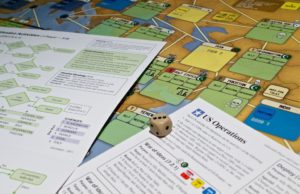
How Do You Create Paper AI?
One of the challenges of board games, and especially more sophisticated historical simulation games, is finding the opponents and the time to play. In the past decade or so, we have seen a shift in the hobby towards games that support more robust solitaire play. But until more recently, most solitaire play felt very luck based, and seemed to have little strategic thought behind it. In short, it rarely felt like playing against a “real” player.
But in 2010, GMT Games published ‘Labyrinth: The War on Terror, 2001-?’ by game designer and CIA national security analyst Volko Ruhnke. And as part of this card-driven two-player boardgame about the complex political and military nature of the War of Terror, there was an option to play the game “solo” using a paper AI to tell the human player what to do in various situations.
In 2012, GMT and Volko continued their collaboration, launching a new series of ‘COIN’ games, all of which were multiplayer, card-driven boardgames simulating a conflict in history or in current events. And as these award-winning titles continued to be launched, Volko partnered with other talented designers like Brian Train and Harold Buchanan. And the paper AI, now referred to as a solo “bot” (as in “robot”), continued its development as well.
Other designers built up this path, with Mark Herman creating a robust solo bot for the 2nd edition of his famed historical game Empire of the Sun: The Pacific War, 1941-1945

image from Empire of the Sun, by Mark Herman and GMT and via: http://www.insidegmt.com/?p=18573
Designer VPJ Arponen noted in http://www.insidegmt.com/?p=16740 that:
In a COIN “bot”, the intelligence comes from the fact that the “bot”, so to speak, monitors the board state and makes decisions based on that monitoring. If you look at a COIN “bot” flowchart, you’ll see it’s structured around a set of questions – something like, does a given faction have so many pieces available, or could a given action, taken right now, produce such and such a result. The questions, therefore, as it were, monitor what are supposed to be the essential features of the board state in what comes to the “bot” action selection. Once a particular action gets selected, a host of “if something, then something” type of clauses further refine the execution of the chosen action.
The result is a “bot” that with a few rules exceptions, plays the game like a human player would – only not always quite as creatively and flexibly as a human player.
In some ways, most COIN games resemble chess: you’ve got to be thinking a few turns ahead and strategically place your pieces such that you enable some critical actions of your own while you prevent your enemies from undertaking actions that damage you. It is my view that the “bots” only manage to provide the superb solitaire experience that they do, because they are intelligent enough to deal with this chess-like quality of the game. Without such an ability, the solo play would not be the same.
So looking at this from a GDT lens, we can see that the AI bot designers are trying to replace the experience of having another player at the table. There is a firm set of rules (Mechanics from the MDAO framework) that cause some different and hopefully better situations (Dynamics from MDAO) that engender better feelings (Aesthetics from MDAO) in the human player. And what is the desired Outcome? To feel like the game is playing “harder” without relying on either random die rolls or “cheating” by giving the AI bot advantages that the solo human player wouldn’t normally have.
And this is not simply for replacing a second player in a two player game. In some COIN games there can be three different solo bots, with each “playing” a faction in what is normally a four person game. Or perhaps a group of three human players wants to use a solo bot to play the fourth faction in the game.
These solo bots continue to improve in both efficacy and ease-of-use, and will be an interesting trend to watch.

